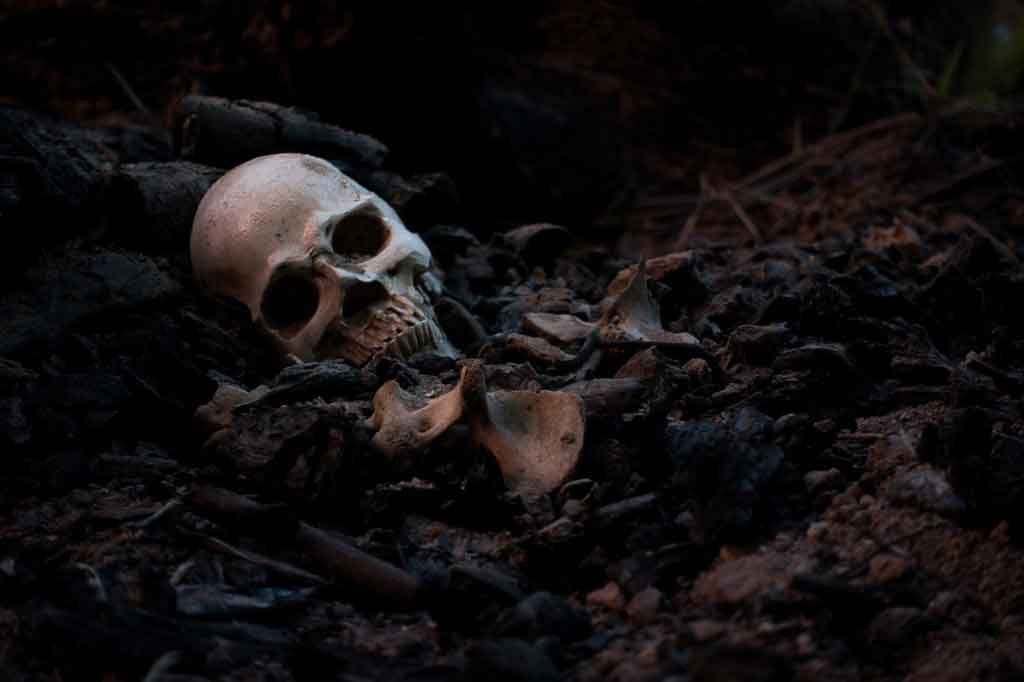Grab your shovel and a rope, we’re going to go dig up two bodies. It won’t take long; we just need their heads. We’ll start by making our way down the Battle Road from Concord Center towards the neighboring town of Lincoln, retracing the frantic footsteps of King George’s men as they fled back to Boston on April 19th, 1775. The unexpected battle at the North Bridge still ringing in their ears, the British troops and colonists were engaged in an 18-mile battle back to Boston, sometimes collectively referred to as “The Battle of Concord.” Along the road in Lincoln, near Hartwell’s Tavern, a colonist’s musket ball slammed into the head of a British solider. Legend says that, on impact, the soldier’s body levitated high into the air before crashing dead to the ground. Around him, four more British soldiers were struck down, blood seeping through their blood red jackets into the dirt of centuries now below our feet.
For the rest of that fateful day and well into the next, these five soldiers, likely Brigadiers given their height and stature, lay on the road. Later in the day, Edmund Wheeler, a local farmer, dragged them onto a cart and pulled them to a nearby graveyard in Lincoln. There, he dug a pit on the edge reserved for paupers and undesirables and buried them together.
Years passed, and with them, changes in England and America’s identities. Yet both shared an increasing study of science and medicine, which included a need for human anatomy subjects for dissection and experiments. The bodies of the poor and criminals were freely turned over to medical schools, but this supply did not meet the demand. Additional bodies came from professional body snatchers, “resurrectionists” as they called themselves (hinting at the Bible’s reference to the dead rising upon the day of judgment). The legality and ethics fell in a gray area, but the money to be made was golden.
In 1815, Massachusetts banned the possession of an unauthorized body, but the demand for them didn’t stop. To avoid detection, the body snatching had to be done quickly and experienced resurrectionists had it down to an art: begin at the head, dig a hole just large enough to break through the top of a coffin to expose the head and shoulders, then take a rope, feed it under the deceased’s arms to make a loop, and heave! The body would follow. Then, quick! Throw it over your shoulder or into a cart and make your way to the buyer before daylight.
Buyers were usually discreet, but on occasion, such as in the case we are about to dig up, acquirers would publicly reach out with their requests.
Sometime in the 1830s, Massachusetts resident Walton Felch, a former cotton mill superintendent and poet, was studying and promoting the relatively new pseudoscience of phrenology, the interpretation of boney bumps on the head. Started in 1790 by Viennese physician Franz Joseph Gall, who thought peoples’ characters and innate intelligence could be determined by measuring the bumps on their heads, phrenology was becoming the craze with practitioners across Europe and America. Followers of phrenology included Walt Whitman who commissioned a reading of his own head, and there was great public interest in the topic. Lectures sold out and presenters were motivated to give audiences a good show - complete with sensation and skulls!

Felch reached out to the Select Board of Lincoln and requested permission to take two skulls from the grave. Now this is the part where you grab your shovels and rope because permission was presumably granted and the grave unearthed. The digging up of the soldiers and taking of their heads was witnessed by William Wheeler (Edmund Wheeler’s grandson) who later narrated the events to Henry David Thoreau. In an 1850 journal entry, written after visiting the cemetery in Lincoln, Thoreau wrote,
“A few years ago one Felch, a phrenologist, by leave of the selectmen dug up and took away two skulls [from this cemetery]. The skeletons were very large, probably those of grenadiers. William Wheeler who was present, told me this… William Wheeler, saw a bullet-hole through and through one of the skulls.”
With the two skulls of the British soldiers in his possession, Felch took to the road displaying the skulls in his lectures, including bringing the skulls to their likely least-favorite town in America, Concord, where Felch was booked to give four lectures at the Concord Lyceum.
The traveling “British soldiers’ skulls” became well known, including to members of the American Antiquarian Society, among whom was Concord-born George Frisbee Hoar. A lawyer and Massachusetts State Senator, Hoar felt a certain unease with the skulls being out and about like this, and after Felch died, Hoar and the Worcester Society of Antiquity approached Felch’s widow about acquiring the skulls to rebury them. One account says Felch’s widow agreed to give the skulls to them… for a price. Alas, poor Yorik, you’re expensive. But, the price would be 50% off because only one skull— the one with the bullet hole in it— could be found. (It is theorized that on his deathbed, Felch gave the second skull to his attending physician, Dr. Bates, who collected antiquities. Despite Hoar’s efforts to recover it, it remains lost in history’s fog of unlocatable objects).

The skull with the bullet hole was sent to Concord. It’s possible that Hoar and others involved did not know the exact location from whence this skull had come; they may only have known that it was the skull of a British soldier killed during the day-long “Battle of Concord.” In 1891, in secrecy and in a manner not to draw public attention to the desecrated remains of a fallen adversary, the skull is thought to have been quietly buried in the grave of two other British soldiers that is located near the North Bridge in Concord.
The few men in attendance signed a document bearing witness to the burial. The document ended up in a museum but, as of this day, it cannot be located. So, here we put down our shovels and rope, and we ask, how many lie below the grave at the North Bridge? This mysterious case of the traveling British soldiers’ skulls will have no ending until perhaps, one day, a grave is once more dug up and one, two, or three skulls, are once more brought into the light of day.
All photos ©istock.com
Places to Visit
• Grave of the British Soldiers at the Old North Bridge
• The Battle Road from Concord to Lincoln, part of Minute Man National Historical Park. Details: www.nps.gov/mima/the-battle-road.htm
Select Sources:
• Journal of Henry David Thoreau, May 31, 1850
• The Journals of Edmund Quincy Sewall, 1837-1840, (n.d), retrieved from www.americanantiquarian.org/sewall-vol4
• Proceedings of the Worcester Society of Antiquity, Volume 21, pg. 140-141
• Sabin, Douglas P., (2011), April 19, 1775: A Histographical Study
• Mathis, R., Watras, J., and Dort, J. (2016). Grave Robbing in the North and South in Antebellum America. American College of Surgeons


